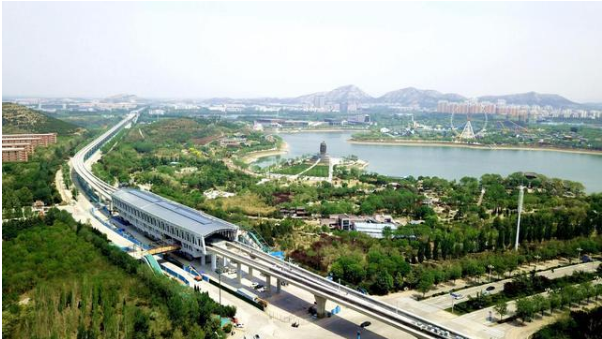The national "Qingdao urban rail Transit Public service standardization pilot project" pas
By the end of June 2020, 31 cities had opened subways, and by the end of the year, the number will increase to 44. The total length of the railways in operation will reach 7,773 kilometers, accounting for 28% of the total length of the world.

The 10 cities with the most new subway mileage in the second half of the year are: Chengdu with 216 km, Shenzhen with 107 km, Xi 'an with 83 km, Qingdao with 69 km, Shanghai with 67 km, Zhengzhou with 55 km, Ningbo with 52 km, Chongqing with 52 km, Kunming with 51 km and Hangzhou with 38 km.
In the second half of the year, 1,083 kilometers of new subway lines are expected to be added, more than all the other countries in the world combined. Once again, the infrastructure maniacs are against the world!
In fact, China's subway era is just beginning, with 43 cities planning subways and some already under construction. Let's look at metro (light rail) planning for major cities by 2035!

1. Eight cities have a planned mileage of over 1,000 kilometers
Shenzhen has the most planned mileage, 1335 kilometers. What is this concept? London is now 402 km, New York 380 km, Moscow 365 km, Tokyo 326 km, Delhi 317 km and Seoul 314 km.
The cities with a planned mileage of more than 1,000 kilometers are: Shenzhen, Beijing, Shanghai, Hangzhou, Wuhan, Suzhou, Tianjin and Nanjing. At present, the highest completion rate is 69.24% in Shanghai and the lowest is 15.81% in Suzhou.

2. The planned mileage of 13 cities is 500-999 kilometers
Xi 'an, Zhengzhou, Guangzhou and Dalian are planned to cover more than 900 km and Qingdao more than 800 km, which makes Chongqing's 750 km and Chengdu's 700 km seem conservative!
Nanchang, the capital of Jiangxi province, has a planned length of 620km, which would be a bit much without merging neighboring counties and cities.
Shenyang is 610 km, Kunming and Foshan are 562 km, and Jinan and Ningbo are 500 km. However, the long-term plan of Jinan is very ambitious, with 47 lines of 1,700 kilometers, which is the first in the world.

3. The planned mileage of 15 cities is 300-499 kilometers
In addition to guiyang, hefei, Harbin, changchun, changsha, fuzhou, the provincial capital and plan single row in xiamen city, some common level city metro planning also reached 300 kilometers, 330 km, such as changzhou nantong 324 kilometers, 323 kilometers xuzhou, wuhu 320 kilometers, 310 kilometers in huizhou, 300 kilometers wenzhou, zhongshan, mainly cantonese but three big economic strong province of economy strong city.
4. The planned mileage of 26 cities is 150-299 kilometers
The most notable ones are 271 km from Quanzhou, 239 km from Jining, 229 km from Yantai, 226 km from Liuzhou, 220 km from Zhuhai, 212 km from Handan, 210 km from Baoding, 207 km from Hengyang, 191 km from Xiangyang, 185 km from Jiujiang, 167 km from Weifang, and 150 km from Yichang.

5. The planned mileage of the other 24 cities is within 150 kilometers
The built-up area of third-tier cities is usually about 200 square kilometers, and the urban resident population is between 1.5 million and 2 million. The subway of 100 kilometers can be built with 3-4 lines, basically covering the main built-up areas.
6. Which cities are eligible to build subways?
At present, the state has three standards for urban subway construction: 1. The budget revenue of general public finance should be over 30 billion yuan; 2. 2. GDP above 300 billion yuan; 3. The permanent urban population is more than 3 million. The nantong that is building subway, Luoyang city urban permanent resident population all did not have 3 million, but got approval, visible urban permanent resident population 2.5 million above, whole city population 6 million above, also be ok.
Still have a kind of situation, compared with the city subway near cities (usually within 30 kilometers), can also apply for opening of the subway, in the form of extension three indicators are not legally binding, such as zhangzhou, langfang, wuhu, maanshan, chuzhou, kunshan city, zhuhai, zhongshan is in the building of the subway or light rail in this way, zhuzhou, xiangtan, kaifeng, xinxiang and deyang, weinan, JiHe, weihai this way opened the subway or light rail is also available.

According to the above three criteria, the cities that are currently eligible to apply for the metro are: Huizhou, Quanzhou, Linyi, Jining, Yantai, Shaoxing, Weifang, Zibo, Jinhua, Yangzhou - Taizhou, Zhenjiang, Jiaxing, Tangshan.
Within 5 years to meet the standards of the cities are: Liuzhou, Handan, Baoding, Hengyang, Xiangyang, Zhanjiang, Yichang, Jiujiang, Nanyang, Huaian, Yancheng, Lianyungang and so on.
In the next five years, all third-tier cities with strong economic strength will meet the standards of subway construction. The era of subway in third-tier cities is coming! Ten years from now, almost all the 86 cities in the table will enter the subway era. By then, The total length of China's subway will exceed 20,000 kilometers, accounting for 40% of the total length of the world!

In the future, the subway will make China's population more concentrated in the big cities, and most small and medium-sized cities will face a life and death catastrophe. A large number of people will be lost, and one-third of the small cities will disappear! Therefore, third-tier cities should speed up population urbanization, promote subway construction, establish themselves as central cities within the region, and avoid the situation of future recession.
There will be only two kinds of cities in China in the future: cities with subways and cities without subways!
测试信息,上线后请删除掉
 中 | ENGLISH
中 | ENGLISH Bidding system
Bidding system Recruitment
Recruitment